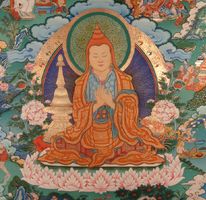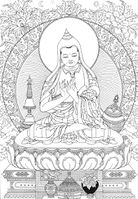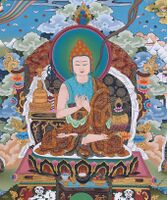Atiśa
| Wylie | jo bo rje a ti sha |
|---|---|
| Romanized Sanskrit | Atiśa Dīpaṃkara Śrījñāna |
| English Phonetics | Atiśa |
| Sort Name | Atiśa |


- དཔལ་མར་མེད་མཛད་དཔལ་ཡེ་ཤེས་
- སློབ་དཔོན་ཆེན་པོ་དཔལ་མར་མེ་མཛད་ཡེ་ཤེས་
- རྒྱ་གར་གྱི་མཁན་པོ་དཔལ་ལྡན་མར་མེ་
- རྒྱ་གར་གྱི་མཁན་པོ་དཔལ་ལྡན་མར་མེ་མཛད་བཟང་པོ་ཡེ་ཤེས་སྙིང་པོ་
- དཱི་པཾ་ཀ་ར་ཤྲཱི་ཛྙཱ་ན་
- པཎྜིཏ་དཱི་པཾ་ཀ་ར་
- མགོན་པོ་ཨ་ཏི་ཤ་
- dpal mar med mdzad dpal ye shes
- slob dpon chen po dpal mar me mdzad ye shes
- rgya gar gyi mkhan po dpal ldan mar me
- rgya gar gyi mkhan po dpal ldan mar me mdzad bzang po ye shes snying po
- dI paM ka ra shrI dz+nyA na
- paN+Dita dI paM ka ra
- mgon po a ti sha
- Atīśa
- Atiśa Dīpaṃkara
- Dīpaṃkara Śrījñāna
- Śrī Dīpaṃkarajñānapada
- Dīpaṃkararakṣita
| Birth: | 982 |
|---|---|
| Death: | 1054 |
Tibetan calendar dates
- Teachers
- Nāropa · Suvarṇadvīpa Dharmakīrti · Bodhibhadra
- Students
- 'brom ston pa · rin chen bzang po · lha btsun byang chub 'od · mgos khug pa lhas btsas · rngog legs pa'i shes rab
Other Biographical info:
- BDRC Link
- https://www.tbrc.org/#!rid=P3379
- Treasury of Lives Link
- http://treasuryoflives.org/biographies/view/Atisa-Dipamkara/5717
- Treasury of Lives Excerpt
- Himalayan Art Resources Link or Other Art Resource
- https://www.himalayanart.org/items/973
- Wiki Pages
The full Tertön Gyatsa text can be found at the following page: Volume 1 (ཀ), 341-765, 1a1-213a4.
Name in Gyatsa: ཇོ་བོ་རྗེ་དཱི་པཾ་ཀ་ར་ (jo bo rje dI paM ka ra)
Page #s for bio of this person: 517 to 518
Folio #s for bio of this person: 89a3 to 89b4
།སངས་རྒྱས་སྣང་བ་མཐའ་ཡས་དང་གུ་རུ་པདྨ་དབྱེར་མེད་པའི་རྣམ་འཕྲུལ་ས་གསུམ་དུ་གྲགས་པས་ཁྱབ་པའི་དཔལ་ལྡན་ཇོ་བོ་རྗེ་དཱི་པཾ་ཀ་ར་ནི་འཕགས་བོད་གཉིས་ན་ཡོངས་སུ་གྲགས་པའི་མཁས་གྲུབ་ཆེན་པོ། བྱང་ཆུབ་སེམས་ཀྱི་མངའ་བདག་བོད་ཁམས་ལ་བཀའ་དྲིན་ལྷག་པར་ཆེ་བ་སྟེ། རྣམ་ཐར་གྲགས་ཆེ་བས་འདིར་མ་བཀོད་ཅིང་། རྗེ་བཙུན་སྒྲོལ་མས་ལུང་གིས་བསྐུལ་ཞིང་བོད་ཀྱི་རྒྱལ་པོས་སྤྱན་དྲངས་པ་ལྟར་གངས་ཅན་དུ་ཕྱགས་ཕེབས། སངས་རྒྱས་ཀྱི་བསྟན་པའི་ག་དར་མཛད་ཅིང་ཉམས་པ་རྨང་ནས་གསོས། ལྷ་སར་རང་བཞིན་གྱི་རྣལ་འབྱོར་མ་ཕལ་པའི་སྣང་ངོར་སྨྱོན་མར་བརྫུ་བ་ཞིག་གིས་ལུང་བསྟན་ཏེ་ཀ་བ་བུམ་པ་ཅན་ནས་འདོམ་ཕྱེད་གཞལ་བའི་ས་ནས་ཆོས་རྒྱལ་སྲོང་བཙན་སྒམ་པོའི་བཀའ་ཆེམས་ཀྱི་ཡི་གེ་ཆེན་པོ། བཙུན་མོ་རྣམས་ཀྱིས་བཀོད་པའི་ལོ་རྒྱུས་དར་དཀར་གསལ་བ། བློན་པོ་རྣམས་ཀྱིས་བྱས་པའི་ལོ་རྒྱུས་ཟླ་བའི་འདོད་འཇོ་བཅས་དཀར་ཆག་ཤོག་དྲིལ་གསུམ་བཞེས། གཏེར་སྲུང་གཉན་པས་དེ་ཉིན་རང་དུ་རྣལ་འབྱོར་པ་སོགས་མི་བཞིས་ཞལ་བཤུས། དོ་ནུབ་སླར་སྦ་དགོས་པས་ལྷག་མ་བག་ཙམ་ལུས་པར་བཤད། ཇོ་བོས་རྣལ་འབྱོར་པ་ཆེན་པོ་ལ་གཏད། དེས་བྱ་ཡུལ་པ། དེས་ཐུགས་རྗེ་ཆེན་པོའི་ཆེ་བའི་ཡོན་ཏན་ཞིག་ལྷ་སའི་དཀོར་གཉེར་ལ་གནང་། མཐིང་ཤོག་ལ་གསེར་གྱིས་བྲིས་པའི་བུ་ཡིག་གདུང་རྟེན་དང་མ་ཕྱི་གློ་འབུར་གྱི་རྟ་མགྲིན་ལྡེར་སྐུ་ལ་བཅུག་སྐད། གཞན་ཡང་ཇོ་བོ་འདིས་འཕགས་ཡུལ་ནས་ཀྱང་བྷེ་ཏ་པདྨ་ཅན་གྱི་ལྷ་ཁང་ནས་གཙུག་ཏོར་སྡེ་ལྔའི་རྒྱལ་མཚན་འཛུག་པའི་ཆོ་ག་སོགས་གཏེར་ནས་བཞེས་པའང་གྲགས་སོ།
sangs rgyas snang ba mtha' yas dang gu ru pad+ma dbyer med pa'i rnam 'phrul sa gsum du grags pas khyab pa'i dpal ldan jo bo rje dI paM ka ra ni 'phags bod gnyis na yongs su grags pa'i mkhas grub chen po/_byang chub sems kyi mnga' bdag bod khams la bka' drin lhag par che ba ste/_rnam thar grags che bas 'dir ma bkod cing /_rje btsun sgrol mas lung gis bskul zhing bod kyi rgyal pos spyan drangs pa ltar gangs can du phyags phebs/_sangs rgyas kyi bstan pa'i ga dar mdzad cing nyams pa rmang nas gsos/_lha sar rang bzhin gyi rnal 'byor ma phal pa'i snang ngor smyon mar brdzu ba zhig gis lung bstan te ka ba bum pa can nas 'dom phyed gzhal ba'i sa nas chos rgyal srong btsan sgam po'i bka' chems kyi yi ge chen po/_btsun mo rnams kyis bkod pa'i lo rgyus dar dkar gsal ba/_blon po rnams kyis byas pa'i lo rgyus zla ba'i 'dod 'jo bcas dkar chag shog dril gsum bzhes/_gter srung gnyan pas de nyin rang du rnal 'byor pa sogs mi bzhis zhal bshus/_do nub slar sba dgos pas lhag ma bag tsam lus par bshad/_jo bos rnal 'byor pa chen po la gtad/_des bya yul pa/_des thugs rje chen po'i che ba'i yon tan zhig lha sa'i dkor gnyer la gnang /_mthing shog la gser gyis bris pa'i bu yig gdung rten dang ma phyi glo 'bur gyi rta mgrin lder sku la bcug skad/_gzhan yang jo bo 'dis 'phags yul nas kyang b+he ta pad+ma can gyi lha khang nas gtsug tor sde lnga'i rgyal mtshan 'dzug pa'i cho ga sogs gter nas bzhes pa'ang grags so
- Person description or short bio
- Indian Buddhist monk and scholar revered by Tibetan Buddhists as a leading teacher in the later dissemination (phyi dar) of Buddhism in Tibet. His name, also written as Atisha, is an Apabhraṃśa form of the Sanskrit term atiśaya, meaning “surpassing kindness.” Born into a royal family in what is today Bangladesh, Atiśa studied Mahāyāna Buddhist philosophy and tantra as a married layman prior to being ordained at the age of twenty-nine, receiving the ordination name of Dīpaṃkaraśrījñāna. After studying at the great monasteries of northern India, including Nālandā, Odantapurī, Vikramaśīla, and Somapura, he is said to have journeyed to the island of Sumatra, where he studied under the Cittamātra teacher Dharmakīrtiśrī (also known as guru Sauvarṇadvīpa) for twelve years; he would later praise Dharmakīrtiśrī as a great teacher of bodhicitta. Returning to India, he taught at the Indian monastic university of Vikramaśīla. Atiśa was invited to Tibet by the king of western Tibet Ye shes 'od and his grandnephew Byang chub 'od, who were seeking to remove perceived corruption in the practice of Buddhism in Tibet. Atiśa reached Tibet in 1042, where he initially worked together with the renowned translator Rin chen bzang po at Tho ling monastery in the translation of prajñāpāramitā texts. There, he composed his famous work, the Bodhipathapradīpa, or “Lamp for the Path to Enlightenment,” an overview of the Mahāyāna Buddhist path that served as a basis for the genre of literature known as lam rim (“stages of the path”). (Source: "Atiśa Dīpaṃkaraśrījñāna." In The Princeton Dictionary of Buddhism, 77. Princeton University Press, 2014. http://www.jstor.org/stable/j.ctt46n41q.27.)
Expand to see this person's philosophical positions on Buddha-nature.
| Is Buddha-nature considered definitive or provisional? | |
|---|---|
| Position: | |
| Notes: | |
| All beings have Buddha-nature | |
| Position: | Qualified Yes |
| If "Qualified", explain: | He uses it as a support for his position on a single vehicle and describe it is a disposition which is a causal potential for buddhahood. |
| Notes: | "The term “innate śīla” means that all sentient beings have a single [or universal] spiritual disposition (gotra), Buddha-nature, or the spiritual disposition of the Mahāyāna." Kano, K., Buddha-Nature and Emptiness, p. 100. |
| Which Wheel Turning | |
| Position: | |
| Notes: | |
| Yogācāra vs Madhyamaka | |
| Position: | Madhyamaka |
| Notes: | Actually Great Madhyamaka. See Kano, K., Buddha-Nature and Emptiness, p. 101. |
| Zhentong vs Rangtong | |
| Position: | |
| Notes: | |
| Promotes how many vehicles? | |
| Position: | 1 |
| Notes: | "In his auto-commentary on the Bodhipathapradīpa, Atiśa explains the term so sor thar pa’i sdom pa and associates the Buddha-nature doctrine with that of the Great Madhyamaka (dbu ma chen po), which teaches that there is nobody who is not a recipient of the Mahāyāna (i.e. ekayāna)." Kano, K., Buddha-Nature and Emptiness, p. 101. |
| Analytic vs Meditative Tradition | |
| Position: | |
| Notes: | |
| What is Buddha-nature? | |
| Position: | Tathāgatagarbha as a Causal Potential or Disposition (gotra) |
| Notes: | "Atisa explains “the innate śīla" abiding in every being as a cause that brings one attainment (i.e. nirvāṇa), but as being covered with defilements in the state of ordinary beings. He takes it as synonymous with Buddha-nature or the mahāyānagotra." Kano, K., Buddha-Nature and Emptiness, p. 101. |
| Svātantrika (རང་རྒྱུད་) vs Prāsaṅgika (ཐལ་འགྱུར་པ་) | |
| Position: | |
| Notes: | |
| Causal nature of the vajrapāda | |
| Position: | |
